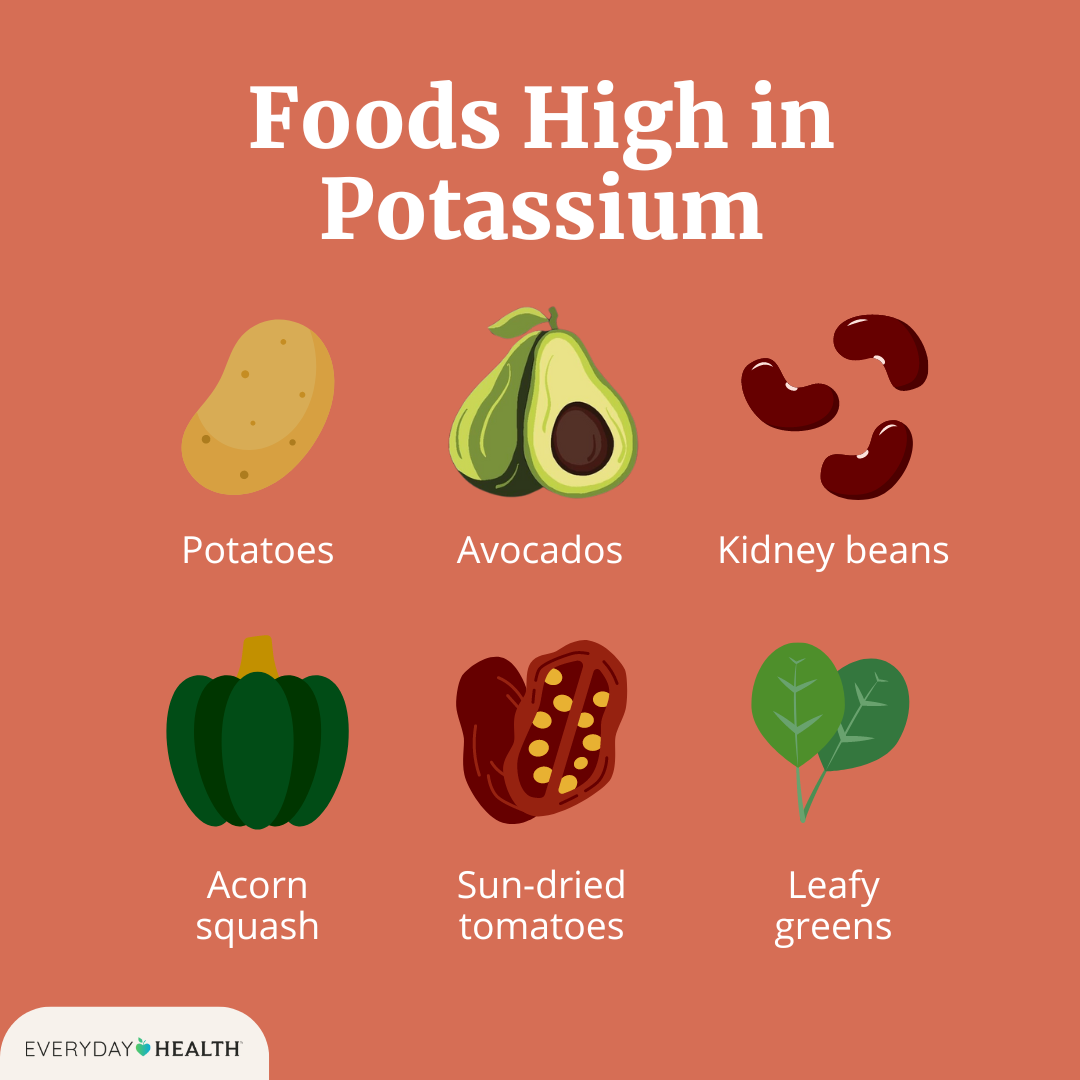
[Source: everyday health.com]
Introduction to Potassium
What is Potassium?
Potassium is an essential mineral that plays a crucial role in maintaining overall health and bodily functions. This electrolyte is necessary for various physiological processes and cannot be produced by the body itself, meaning we must obtain it through our diet. [#1]
Found primarily inside our cells, potassium works alongside other minerals like sodium, calcium, and magnesium to keep our bodies functioning properly. It’s one of the most abundant minerals in the human body, highlighting its significance in maintaining good health.
Why You Need Potassium
The importance of potassium in your daily diet cannot be overstated. This vital mineral contributes to several key functions:
- Regulates fluid balance within and outside cells
- Supports proper muscle contractions, including your heart muscle
- Helps maintain normal blood pressure levels
- Facilitates nerve signal transmission throughout the body
- Assists in moving nutrients into cells and waste products out
Without adequate potassium, these essential processes can become compromised, potentially leading to various health issues ranging from mild to severe. Getting enough potassium through your diet is a fundamental aspect of maintaining optimal health. [#2]
Potassium’s Role in the Body
Diving deeper into how potassium functions within your body reveals its far-reaching impact on your health. This mineral works as an electrolyte, which means it carries an electric charge when dissolved in bodily fluids like blood. This electrical property is what enables potassium to fulfill its many roles.
One of potassium’s primary functions is maintaining proper fluid balance. It works in opposition to sodium to regulate the amount of water inside and outside your cells. This balancing act is critical for preventing dehydration and water retention while supporting optimal cellular function. [#3]
Additionally, potassium is indispensable for muscle function. Every time you move a muscle, potassium helps facilitate that contraction. This includes not just your skeletal muscles but also smooth muscles in your digestive tract and, most importantly, your cardiac muscle. Your heartbeat relies on the proper exchange of potassium and other electrolytes. [#4]
The nervous system also depends heavily on potassium. Your nerves communicate through electrical impulses, and potassium is essential for generating and transmitting these signals. From basic reflexes to complex thought processes, potassium helps make it all possible.
Furthermore, potassium contributes to bone health, helps regulate blood sugar levels, and may even play a role in reducing the risk of kidney stones. Its widespread influence throughout the body makes it one of the most valuable nutrients for maintaining good health.
Recommended Potassium Intake
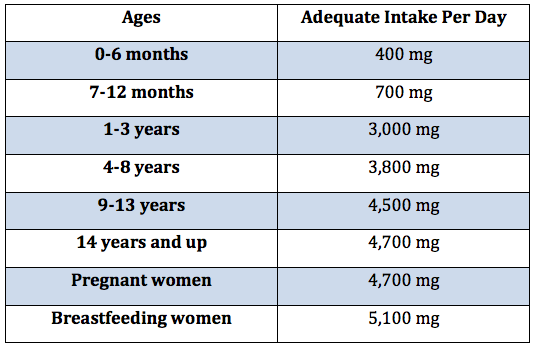
[Source: study.com]
How Much Potassium Do You Need?
Understanding the right amount of potassium your body needs is essential for maintaining optimal health. According to the Food and Drug Administration (FDA), adults should aim for approximately 4,700 milligrams of potassium daily. This recommendation helps support proper muscle function, nerve transmission, and blood pressure regulation. [#5]
However, research shows that most Americans fall short of this target. Studies indicate that the average daily consumption is significantly lower than recommended levels—about 2,320 mg for women and 3,016 mg for men. This gap between recommended and actual intake highlights a potential nutritional shortcoming in many diets.
Different life stages and conditions may require adjustments to potassium intake. For instance:
- Pregnant women might need slightly higher amounts to support fetal development
- Athletes and those who sweat heavily may require additional potassium to replace what’s lost through perspiration
- Older adults often need to pay special attention to their potassium levels as kidney function naturally declines with age
- People taking certain medications may need modified intake levels
Bridging this nutritional gap doesn’t necessarily require supplements. A thoughtful approach to meal planning that incorporates potassium-rich foods can help you reach the recommended daily amount naturally through your diet.
Signs of Deficiency and Toxicity
Your body has sophisticated mechanisms to maintain proper potassium balance, but sometimes these systems falter. Recognizing the warning signs of imbalance can help you take appropriate action before serious health complications develop.
Low potassium levels, a condition known as hypokalemia, can manifest through various symptoms that affect multiple body systems. Watch for these potential indicators:
- Muscle weakness, cramps, or spasms
- Fatigue and general weakness
- Abnormal heart rhythms or palpitations
- Digestive problems including constipation
- Tingling or numbness sensations
- Increased thirst and urination
On the flip side, excessive potassium in the bloodstream, called hyperkalemia, can be equally problematic and potentially more dangerous. This condition is less common in healthy individuals with normal kidney function but may occur in those with certain medical conditions or who take specific medications. Signs of high potassium levels include:
- Nausea and vomiting
- Chest pain or heart palpitations
- Breathing difficulties
- Irregular heartbeat
- Muscle weakness or paralysis
It’s worth noting that both deficiency and toxicity can sometimes present with subtle or no symptoms until they reach critical levels. This underscores the importance of regular health check-ups and blood tests, particularly for those with risk factors such as kidney disease, diabetes, or use of certain medications.
Maintaining the right balance of potassium involves more than just monitoring intake—it’s about understanding how this mineral interacts with other nutrients in your body. For example, sodium and potassium work as a team to regulate fluid balance and blood pressure, making them key components of your body’s fundamental macronutrient needs.
Potassium-Rich Foods
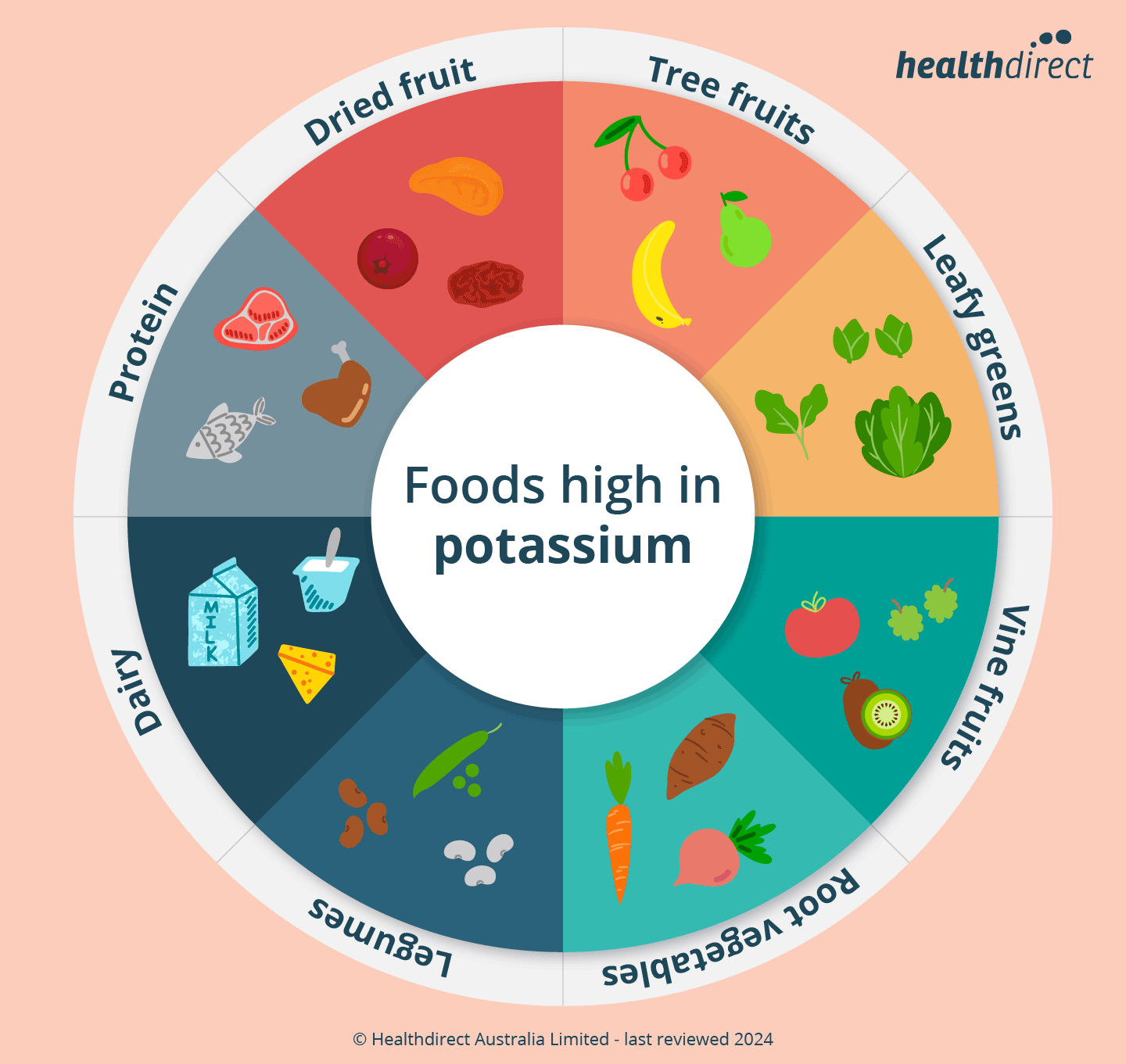
[Source: healthdirect.gov.au]
High Potassium Foods
Incorporating potassium-rich foods into your daily meals doesn’t have to be complicated. Nature provides an abundance of delicious options that can help you reach your daily potassium goals while enjoying varied and flavorful meals.
Fruits represent some of the most accessible sources of this vital mineral. Bananas might be the first food that comes to mind when thinking about potassium, but many other fruits pack an impressive potassium punch. Oranges, cantaloupe, honeydew, apricots, and grapefruit all contain significant amounts of this essential nutrient. These sweet treats make perfect snacks or breakfast additions that support your electrolyte balance throughout the day.
For those with a sweet tooth, dried fruits offer concentrated potassium sources in small packages. Raisins, dried apricots, prunes, and dates not only satisfy sugar cravings but also deliver substantial potassium content. Just a small handful can contribute meaningfully to your daily intake goals. However, be mindful of portion sizes as dried fruits also contain concentrated sugars.
The vegetable kingdom provides even more potassium-rich options. Leafy greens like spinach transform when cooked, becoming potassium powerhouses. Other vegetables high in this mineral include broccoli, potatoes (especially with skins), sweet potatoes, mushrooms, peas, cucumbers, zucchini, eggplant, pumpkins, and tomatoes. These versatile ingredients can form the foundation of countless healthy meals.
Protein sources can also contribute significantly to your potassium intake. Fish lovers will appreciate that salmon, tuna, and halibut deliver not only heart-healthy omega-3 fatty acids but also substantial potassium. These seafood options provide multiple nutritional benefits in each serving.
Plant-based protein sources shine in the potassium department too. Legumes such as lentils, kidney beans, and soybeans offer impressive amounts of this mineral alongside their protein content. These versatile ingredients work well in soups, salads, and main dishes, making them practical additions to any meal plan.
Don’t overlook nuts and seeds when seeking potassium sources. Almonds, peanuts, and sunflower seeds contain notable amounts of potassium while also providing healthy fats and protein. A small handful makes an excellent snack that supports multiple aspects of your nutritional needs.
Dairy products round out the list of potassium-rich food categories. Milk and yogurt not only support bone health with their calcium content but also contribute meaningful amounts of potassium to your diet. For those who enjoy dairy, these foods offer a convenient way to boost potassium intake at breakfast or as snacks.
Creating meals with these potassium-rich ingredients doesn’t require culinary expertise. Simple combinations like a spinach salad topped with salmon, a smoothie made with yogurt and banana, or a hearty lentil soup can deliver substantial amounts of this vital mineral without complicated recipes or expensive ingredients.
Low-Potassium Foods
While most people benefit from increasing their potassium intake, some individuals with specific health conditions—particularly kidney disease—may need to limit their consumption of this mineral. Understanding which foods contain lower amounts of potassium becomes crucial for these individuals.
Some fruits that contain relatively lower potassium levels include:
- Apples and apple juice
- Berries such as blueberries, strawberries, and raspberries
- Cranberries and cranberry juice
- Grapes and grape juice
- Pineapple
- Watermelon (in limited amounts)
Vegetables with lower potassium content include:
- Green beans
- Carrots
- Cabbage
- Lettuce
- Onions
- Peppers
- Radishes
Other food options that typically contain less potassium include:
- White rice
- Noodles and pasta
- White bread and bagels
- Certain cereals (those not made with bran or whole grains)
For those who must restrict potassium, a technique called leaching can help reduce the potassium content in certain vegetables. This process involves cutting the vegetables into small pieces, soaking them in warm water for several hours, and then cooking them in fresh water. While this method doesn’t eliminate all potassium, it can significantly reduce the content in potatoes, sweet potatoes, carrots, beets, and winter squash.
Remember that dietary needs vary greatly between individuals. Those with kidney disease or other conditions requiring potassium restriction should work closely with healthcare providers to develop an appropriate eating plan that balances nutritional needs with medical requirements.
Potassium and Health
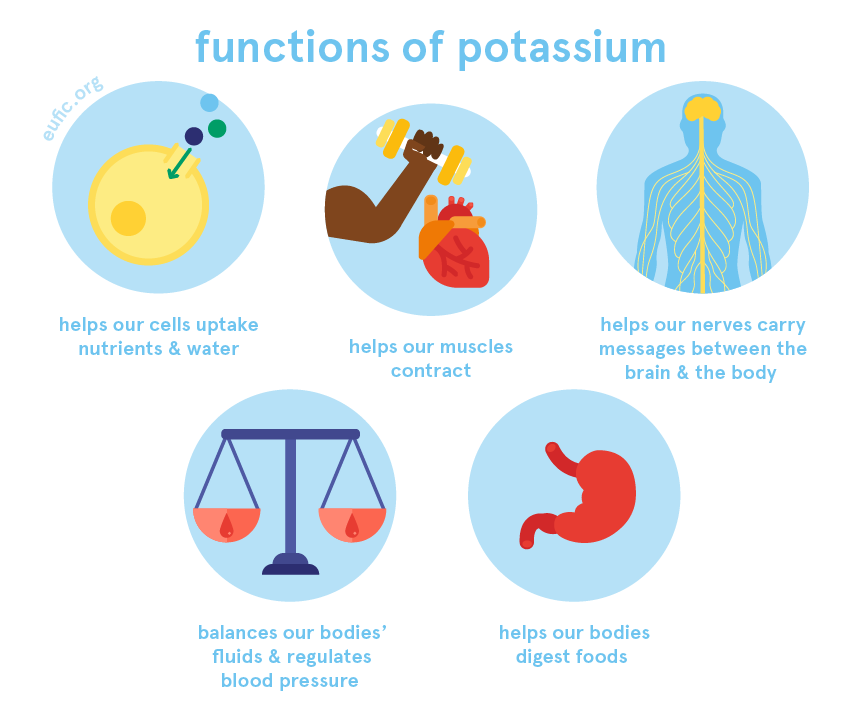
[Source: eufic.org]
The Interplay of Potassium and Sodium
Potassium and sodium work as a dynamic duo in your body, maintaining a delicate balance that affects numerous physiological functions. Think of them as two sides of a seesaw – when one goes up, the other should come down for optimal health. Unfortunately, the typical modern diet often tips this balance in the wrong direction.
Most people consume far too much sodium while getting insufficient potassium. This imbalance can lead to serious health consequences over time. Research has consistently shown that high-sodium, low-potassium diets are associated with increased health risks. A landmark study found that individuals with this dietary pattern had a significantly higher risk of dying from heart attacks or from any cause compared to those with better mineral balance.
Correcting this imbalance doesn’t necessarily mean eliminating salt entirely. Rather, focusing on increasing potassium-rich foods while moderating sodium intake creates a more favorable ratio. This approach proves more sustainable and beneficial than extreme sodium restriction alone.
Health Benefits of Potassium
The advantages of maintaining adequate potassium levels extend throughout your body. This mineral serves as a key player in multiple aspects of health:
- Blood Pressure Regulation: Potassium helps relax blood vessel walls, allowing blood to flow more freely and reducing pressure within the circulatory system. This effect makes potassium particularly valuable for those with hypertension or at risk for developing high blood pressure.
- Heart Health Protection: Beyond blood pressure benefits, potassium supports overall cardiovascular function. It helps maintain regular heart rhythm and improves the efficiency of each heartbeat.
- Stroke Prevention: Adequate potassium intake has been linked to reduced stroke risk, particularly ischemic stroke (caused by blood clots). The protective effect appears strongest when combined with moderate sodium consumption.
- Bone Health Support: Potassium helps neutralize acid load in the body, which can prevent calcium leaching from bones. This protective mechanism may reduce osteoporosis risk and maintain bone density as we age.
- Kidney Stone Prevention: By helping regulate calcium excretion, potassium may reduce the formation of kidney stones in susceptible individuals.
- Water Balance: Potassium works with sodium to regulate fluid levels inside and outside cells. Proper balance helps prevent uncomfortable water retention and bloating.
These benefits highlight why potassium deserves attention in your dietary choices. Small adjustments that increase potassium-rich foods can yield substantial health improvements over time.
Research Behind Acid-Alkaline Diet Claims
The acid-alkaline diet theory suggests that certain foods can affect the body’s pH balance, with some creating acidic conditions and others promoting alkalinity. Proponents claim that a diet rich in alkaline-forming foods (which include many potassium-rich fruits and vegetables) helps prevent disease and promote overall health.
While the body tightly regulates blood pH regardless of diet, research does indicate that potassium-rich foods may help neutralize acid load from protein metabolism. This acid-buffering effect could explain some of the bone-protective benefits associated with high potassium intake.
Studies examining the acid-alkaline theory have produced mixed results. However, the recommendations that stem from this approach—eating more fruits and vegetables while moderating animal protein—align well with established nutritional guidelines. The benefits observed may stem more from increased potassium and other nutrients rather than pH changes per se.
What remains clear is that diets abundant in potassium-rich plant foods consistently correlate with better health outcomes across multiple measures. Whether this results from pH effects, potassium itself, or the combination of nutrients these foods provide remains an active area of research.
For practical purposes, focusing on incorporating more fruits and vegetables into your meals will naturally increase potassium intake while providing numerous other health benefits. This approach proves more straightforward than attempting to micromanage dietary acid load or pH levels.
Practical Tips and Considerations
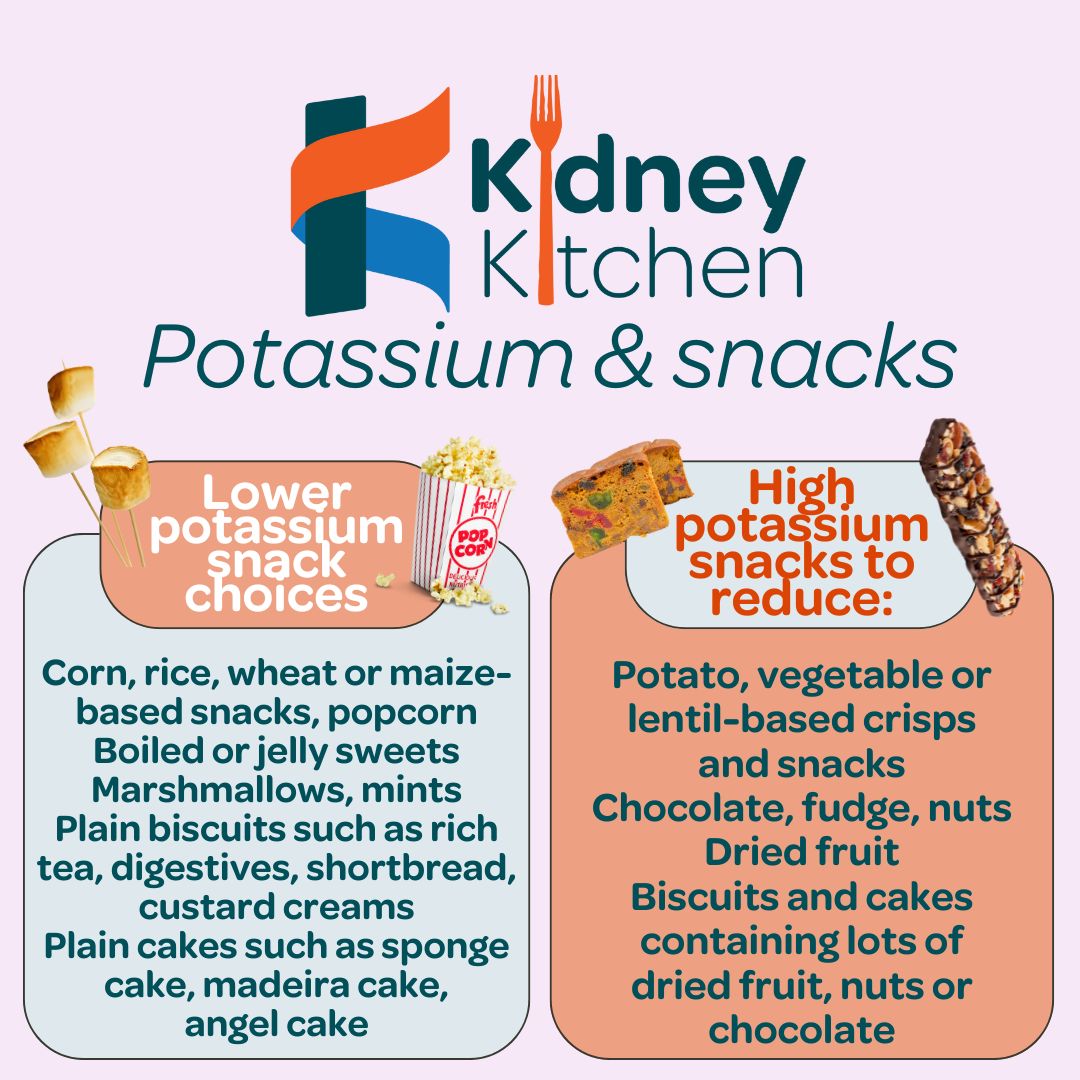
[Source: kidneycareuk.org]
Reading Food Labels for Potassium Content
Navigating food labels for potassium information can be challenging. Unlike sodium, potassium content wasn’t always required on nutrition facts panels. However, updated FDA labeling requirements now mandate potassium listing on most packaged foods, making it easier to track your intake.
When examining labels, remember that potassium amounts are typically shown in milligrams (mg) and as a percentage of Daily Value (DV). The current Daily Value for potassium is 4,700 mg. A food providing 20% or more of the DV is considered high in potassium, while those with less than 5% are low-potassium options.
Look beyond the numbers to understand how processing affects potassium content. Many processed foods have potassium added as preservatives or flavor enhancers, often in forms that may not offer the same benefits as naturally occurring potassium. Ingredients like potassium chloride, potassium citrate, or potassium phosphate indicate added forms of this mineral.
For whole foods without labels, numerous online databases and mobile apps can help you estimate potassium content. The USDA FoodData Central database serves as a particularly reliable resource for nutritional information on thousands of foods.
When to Avoid High Potassium Foods
While potassium offers numerous health benefits, certain medical conditions require limiting intake. People with kidney disease often need to restrict potassium consumption because damaged kidneys cannot remove excess potassium efficiently. This can lead to hyperkalemia (high blood potassium), a potentially dangerous condition affecting heart function.
Several medications can also affect potassium levels in the body, creating situations where dietary adjustments become necessary:
- Potassium-sparing diuretics: Medications like spironolactone reduce potassium excretion while removing excess fluid.
- ACE inhibitors and ARBs: Common blood pressure medications that can raise potassium levels.
- NSAIDs: Long-term use of non-steroidal anti-inflammatory drugs may affect potassium balance.
- Beta-blockers: These heart medications can influence potassium regulation.
If you’re taking any of these medications or have kidney issues, work with your healthcare provider to determine appropriate potassium intake. They might recommend limiting high-potassium foods like bananas, oranges, potatoes, and tomatoes in favor of lower-potassium alternatives.
It’s worth noting that potassium supplements pose particular risks and should never be taken without medical supervision. Unlike dietary potassium, which is absorbed gradually, supplements can cause rapid increases in blood potassium levels. Potassium supplements should only be taken with a doctor’s prescription.
Balancing Potassium with Other Nutrients
Achieving optimal health requires more than just focusing on potassium alone. The interrelationship between potassium and other nutrients, particularly sodium, plays a crucial role in bodily functions. Sodium and potassium in the diet are directly associated with blood pressure regulation.
Rather than viewing nutrients in isolation, consider your overall dietary pattern. The DASH (Dietary Approaches to Stop Hypertension) eating plan exemplifies this balanced approach, emphasizing potassium-rich fruits and vegetables while moderating sodium intake. This eating pattern has consistently demonstrated blood pressure benefits superior to focusing on single nutrients.
For practical implementation, try these balanced approaches:
- Replace processed snacks with fresh fruits or vegetables
- Use herbs and spices instead of salt to flavor foods
- Choose whole foods over processed alternatives whenever possible
- Include a variety of colorful produce to obtain diverse nutrients
- Stay adequately hydrated to support kidney function and electrolyte balance
Many vegetables that are naturally high in potassium also tend to be lower in calories, making them excellent choices for overall health. Incorporating these foods provides multiple benefits beyond just potassium intake.
Remember that dietary changes should be gradual. Suddenly increasing fiber-rich, potassium-containing foods may cause digestive discomfort. Start with small additions and increase slowly to allow your system to adjust. This measured approach helps establish sustainable habits rather than temporary changes.
Frequently Asked Questions

[Source: superoffice.com]
What Foods Have the Highest Potassium?
When looking for potassium powerhouses, several foods stand out for their exceptional content. Dried apricots lead many fruit options, packing about 1,100 mg per cup. Avocados deliver approximately 975 mg in a whole fruit, while a medium baked potato with skin contains roughly 900 mg. For vegetable lovers, cooked spinach offers about 840 mg per cup, and sweet potatoes provide around 700 mg each.
Legumes deserve special mention too. White beans contain approximately 600 mg per cup when cooked, while lentils offer about 730 mg. Among protein sources, salmon stands out with roughly 800 mg in a 6-ounce fillet. Even yogurt makes the list with about 580 mg per cup.
What might surprise many people is that bananas, though famous for potassium, aren’t actually at the top of the list. A medium banana provides about 420 mg—good, but not exceptional compared to the foods mentioned above. This highlights the importance of diversifying your diet beyond the commonly known potassium sources.
What Increases Potassium Quickly?
If you’re looking to boost your potassium levels rapidly, focus on consuming easily digestible forms of the mineral. Coconut water serves as a quick option, delivering about 600 mg per cup with excellent absorption rates. Fresh fruit juices like orange or pomegranate juice can also raise levels relatively quickly, though they contain sugar that some people may need to limit.
For those needing immediate increases, some healthcare providers might recommend oral rehydration solutions that contain balanced electrolytes including potassium. However, it’s crucial to understand that attempting to rapidly increase potassium without medical supervision can be dangerous, particularly for people with certain health conditions.
Remember that potassium supplements should never be taken without a doctor’s prescription, as they can cause dangerous spikes in blood potassium levels. The body absorbs potassium from supplements much faster than from food sources, potentially leading to cardiac complications.
What Are the Signs of Low Potassium?
Recognizing potassium deficiency early can help prevent serious complications. Common symptoms include muscle cramps, especially in the legs, along with general fatigue and weakness that seems disproportionate to your activity level. You might also experience constipation as potassium plays a role in proper digestive function.
More concerning signs include abnormal heart rhythms, which might feel like palpitations or a fluttering sensation in your chest. Some people report tingling or numbness, particularly in their extremities. In severe cases, low potassium can lead to paralysis, respiratory failure, or even cardiac arrest—though these extreme outcomes typically occur only with significant deficiencies.
If you’re experiencing these symptoms, especially after illness involving vomiting or diarrhea, while taking certain medications, or if you have kidney disease, contact your healthcare provider promptly. Blood tests can confirm whether potassium levels are indeed low and help determine appropriate treatment.
How Can I Track My Potassium Intake?
Monitoring your potassium consumption has become easier in recent years. Since May 2016, potassium is required to be listed on Nutrition Facts food labels, making it simpler to track intake from packaged foods.
Several approaches can help you keep tabs on your potassium consumption:
- Food tracking apps: Many nutrition apps now include potassium content in their databases
- Food diaries: Keeping a written record of meals and referencing potassium content from reliable sources
- Label reading: Checking nutrition facts panels on packaged foods
- Working with professionals: Consulting with dietitians who can analyze your intake
For those with medical conditions requiring precise potassium management, more rigorous tracking may be necessary. Some healthcare providers might recommend periodic blood tests to monitor levels, especially when starting new medications or making significant dietary changes.
Remember that tracking doesn’t need to be perfect to be valuable. Even rough estimates can help you identify patterns and make beneficial adjustments to your eating habits over time.
Conclusion
Key Takeaways
Potassium stands as a fundamental mineral that deserves more attention in our daily nutritional considerations. Throughout this article, we’ve explored how this essential electrolyte supports numerous bodily functions—from nerve transmission to muscle contraction and blood pressure regulation. The evidence clearly shows that maintaining adequate potassium levels isn’t just about preventing deficiency; it’s about optimizing health.
High potassium intake offers remarkable benefits for cardiovascular health. Research demonstrates that it can help relax blood vessels and assist the body in excreting excess sodium, contributing to lower blood pressure readings. This blood pressure-lowering effect translates into significant protection against stroke—studies show that higher potassium consumption is associated with a 24% lower risk of stroke.
We’ve identified numerous potassium-rich foods that can help you meet your daily requirements:
- Fruits like dried apricots, avocados, and bananas
- Vegetables including potatoes, spinach, and sweet potatoes
- Legumes such as white beans and lentils
- Protein sources like salmon
- Dairy products including yogurt
Remember that while supplements exist, food sources generally provide potassium in its safest, most bioavailable form. The body processes dietary potassium gradually, reducing the risk of dangerous spikes that can occur with supplement use.
Final Thoughts
Incorporating potassium-rich foods into your diet doesn’t require drastic changes. Small, consistent adjustments can make a significant difference in your overall intake. Try adding a serving of beans to your lunch, snacking on dried fruits, or including more leafy greens with dinner. These simple modifications can boost your potassium consumption substantially.
For most healthy individuals, focusing on whole foods naturally rich in potassium represents the best approach. However, those with specific medical conditions—particularly kidney disease—should work closely with healthcare providers to determine appropriate potassium levels. What serves as healthy for most people might pose risks for others with certain health challenges.
As with many aspects of nutrition, balance remains key. The relationship between potassium and sodium highlights this principle perfectly—these electrolytes work in tandem to maintain proper fluid balance and cellular function. Rather than fixating on a single nutrient, consider how potassium fits within your broader dietary pattern.
By making informed choices about potassium-rich foods and understanding your individual needs, you can harness this mineral’s impressive health benefits while avoiding potential pitfalls. Your heart, muscles, nerves, and overall wellbeing will thank you for paying attention to this often overlooked nutritional powerhouse.
References
- 1. Beyond Bananas: 16 Potassium-Rich Foods
https://health.clevelandclinic.org/potassium-rich-foods - 2. Potassium – The Nutrition Source – Harvard University
https://nutritionsource.hsph.harvard.edu/potassium/ - 3. 10 Potassium-Rich Foods – Baptist Health
https://www.baptisthealth.com/blog/healthy-living/potassium-rich-foods - 4. Foods high in potassium
https://www.healthdirect.gov.au/foods-high-in-potassium - 5. Potassium-Rich Foods: A Comprehensive Guide
https://www.webmd.com/diet/foods-rich-in-potassium